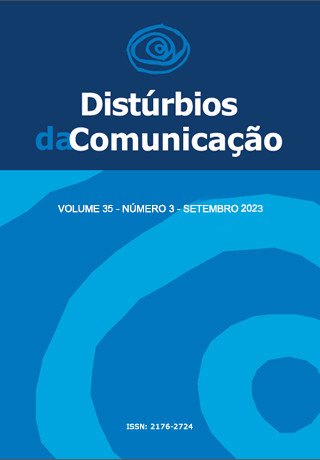Electromyographic rest of the masticatory muscles of patients with temporomandibular disorders before and after speech therapy with and without elastic bandage
DOI:
https://doi.org/10.23925/2176-2724.2023v35i3e57872Keywords:
Temporomandibular joint, Electromyography, Elastic Therapeutic Bandage, Musculoskeletal Manipulations, Temporomandibular Joint Dysfunction SyndromeAbstract
Purpose: Objective: The research aims to verify the electromyographic rest thresholds of the masseter and temporal muscles in patients with temporomandibular disorders (TMD) before and after speech therapy intervention with and without the use of therapeutic elastic bandage. Methods: The collection included 14 female participants, aged between 18 and 40 years, who had a diagnosis of muscular or mixed TMD. The patients were divided into two groups: with traditional therapy (CB) bandage and traditional therapy (SB) only group. The patients underwent initial evaluation, as well as surface electromyography in situations of maximum voluntary contraction and rest and at the end of the four weeks of intervention, a new evaluation was performed with the same instruments. Data analysis occurred quantitatively and qualitatively. Results: In the SB group, the right masseter muscle showed a significant increase in resting values. It was observed that the same occurred for all muscles in this group, influencing the balance of the ipsilateral and contralateral muscles, although without statistical evidence. The CB group did not show statistically significant values, but qualitatively the muscle rest values decreased and balanced in a contralateral way. Conclusion: No statistically significant changes were observed in the resting electromyographic thresholds of the masseter and temporalis muscles in both groups. Qualitatively, there was an increase in electromyographic values after traditional manual therapy in all muscles in the SB group. Regarding the CB group, there was a decrease in electromyographic resting values after therapy, although without statistical evidence.
Downloads
References
Pelicioli M, Myra RS, Florianovicz VC, Batista JS. Physiotherapeutic treatment in temporomandibular disorders. Revista Dor 2017; 18(4): 355-61.
Almeida FL, Silva AMT, Correa ECR, Busanello AG. Relação entre dor e atividade elétrica na presença de bruxismo. Cefac 2011; 13 (3): 399-406.
Hernandes NCDJ, Ribeiro LL, Gomes CF, Silva AP, Dias VF. Atuação fonoaudiológica em disfunção temporomandibular em dois casos: análise comparativa dos efeitos da terapia tradicional e o uso da bandagem terapêutica associada. Distúrbios da Comunicação 2017; 29 (2): 251- 61.
Sassi FC, Silva AP., Santos RKS, Andrade CRF. Tratamento para disfunções temporomandibulares: uma revisão sistemática. Audiology - Communication Research 2018; l (23): 1-13.
Fassicollo CE, Graciosa MD, Graefling BF, Ries LG. Temporomandibular dysfunction, myofascial, craniomandibular and cervical pain: effect on masticatory activity during rest and mandibular isometry. Revista Dor 2017; 18 (3): 250-54.
Berreta F, Freitas, MS, Kuntze MM, Souza BDM. Atuação fonoaudiológica nas disfunções temporomandibulares: Um relato de experiência. R. Eletr. de Extensão 2018; 15 (28): 182-92.
Costa DR, Pacetti GA, Nicolau RM. Transformada wavelet na análise do efeito da terapia LED sobre a atividade do músculo masseter em mulheres com disfunção temporomandibular. Scientia Medica 2018; 2 (28): 1-7.
Pernambuco LA, Cunha RA, Lins O, Leão JC, Silva HJ. A eletromiografia de superfície nos periódicos nacionais em fonoaudiologia. Cefac 2010; 1 (14): 1-8.
Celinski AI, Cunali RS, Bonotto D, Farias, AC, Cunali PF. Eletromiografia de superfície em disfunção temporomandibular: revisão sistemática. Rev Dor 2013; 2 (14): 147-50.
Stefani FM. Estudo eletromiográfico do padrão de contração muscular da face de adultos. 2008. 105 f. Tese (Doutorado) - Curso de Doutor em Ciências, Faculdade de Medicina da Universidade de São Paulo.
Rodrigues AMM, Bérzin F, Siqueira VC. Análise eletromiográfica dos músculos masseter e temporal na correção da mordida cruzada posterior. R Dental Press Ortodon Ortop Facial 2006; 3 (11): 55-62.
Nascimento GKBAO, Cunha DA, Lima LM, Moraes KJR., Pernambuco LA, Régis RMFL, Silva HJ. Eletromiografia de superfície do músculo masseter durante a Mastigação: Uma revisão sistematica. Cefac 2012; 4 (14): 725-31.
Santos NCC. Articulação temporomandibular: anatomia, dinâmica e disfunções temporomandibulares. 2010. 58 f. Monografia (Especialização) - Curso de Cirurgiã-dentista, Unesp.
Stefani SM. Intervenção fonoaudiológica nas disfunções temporomandibulares. In: Novo tratado de fonoaudiologia/ editor Otacílio Lopes Filho, et al. 3ª ed. Barueri, SP: Manole, 2013.
Silva AP, Escamez NES, Júnior NM, Silva MADA. Método TherapyTaping®: bandagem elástica como recurso terapêutico na clínica fonoaudiológica. Disturbios Comunicação 2014; 26 (4): 805-08.
Organización Mundial de la Salud. El estado físico: uso e interpretación de la antropometría. Ginebra: OMS; 1995. (Serie de Informes Técnicos; 854).
Felício CM, Ferrreira CLP. Protocol of orofacial myofunctional evaluation with scores. Int J. Pediatr Otorhinolaryngol 2008; 7(3): 367-75.
Felício CM, Mazzetto MO, Rodrigues da Silva MAM, Betaglion C, Hotta TH. A preliminar protocol for multi-professional centers for the determination of signs and symptoms of temporomandibular disorders. Cranio 2006; 24(4): 258-64.
Dantas AMX, Santos EJL., Vilela RM, Lucena LBS. Perfil epidemiológico de pacientes atendidos em um Serviço de Controle da Dor Orofacial. Revista de Odontologia da Unesp 2015; 44 (6): 313-19.
Motta LJ, Bussadori SK, Godoy CLH, Gonzalez DAB. Disfunção Temporomandibular segundo o Nível de Ansiedade em Adolescentes. Psicologia: Teoria e Pesquisa 2015; 31 (3): 389-95.
Silva AP, Carvalho ARR, Sassi FC, Silva MAA. Os efeitos da bandagem elástica no músculo trapézio em adultos saudáveis. Codas 2019; 31 (5): 1-8.
Nardi V, Campos MIG, Campos PSF, Nascimento MA. Eletromiografia e disfunção temporomandibular. Revista de Ciências Médicas e Biológicas 2010; 1 (9): 53-56.
Sordi C, Araújo BL, Cardoso LVD, Correia LAV, Oliveira GM, Silva SSS, César CPHAR. A bandagem elástica como recurso terapêutico para o controle da sialorreia: análise de sua eficácia. Distúrbios da Comunicação 2017; 29 (4): 663-72.
Mazzetto MO, Paiva G, Magri LV, Melchior MDO, Rodrigues CA. Frequency of electromyographic indices alterations in temporomandibular disorders and their correlation with pain intensity. Revista Dor 2014; 15 (2): 91-95.
Downloads
Published
Issue
Section
License
Copyright (c) 2023 Camila Fernandes, Makelis Oneide dos Santos, Claudia Tiemi Mituuti, Patricia Haas, Fabiane Miron Stefani

This work is licensed under a Creative Commons Attribution 4.0 International License.









